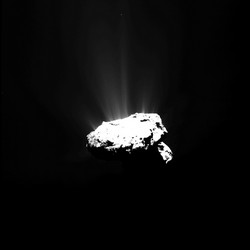Trending science: Rosetta has her ‘day in the sun’
It has been a month of celebrations and milestones for the European Space Agency’s (ESA) Rosetta mission: on 6 August, Rosetta marked one year at Comet 67P/Churyumov–Gerasimenko and then on 13 August, Rosetta followed the comet on its closet approach to the Sun, known as perihelion. Rich data from Rosetta feeds exciting theories This busy month follows a historic year for Rosetta which last August became the first spacecraft ever to orbit a comet and the first to soft land a probe – Philae – on its surface. In the intervening 12 months, the comet has travelled some 750 million kilometres along its orbit towards the Sun and along the way, Rosetta has returned a wealth of outstanding scientific data, spanning its interior, the dramatic surface and the surrounding cloud of dust, gas and plasma. One particularly important discovery has been the first detection of molecular nitrogen in a comet which is said to provide important clues about the temperature environment in which the comet was ‘born’. Molecular nitrogen was common when the Solar System was forming, but required very low temperatures to become trapped in ice, so Rosetta’s measurements support the theory that comets originate from the cold and distant Kuiper Belt. Findings on the comet may also offer important pointers as to how life evolved on Earth. According to the Guardian, the discovery of a ‘rich brew of 14 organic chemicals’ on the comet gives support to the idea that comets, crashing on Earth, might have played a key role in providing materials that led to the appearance of rudimentary life on our world. Eruptions of steam and dust as comet 67P ‘tears past the sun’ Having the chance to observe the comet’s perihelion provided yet more opportunities for space discoveries. Activity on the comet reaches its peak intensity around perihelion and in the weeks that follow, and Rosetta’s navigation camera has been snapping the action along the way. The Guardian notes, ‘Cameras on the Rosetta spacecraft captured powerful jets of steam and dust erupting from comet 67P as it tore past the sun on Thursday morning. Images beamed back from the probe showed the comet spewing material as it warmed up on its closest pass of the sun and began its journey back out into the frigid far reaches of the solar system.’ Holger Sierks, the lead scientist on Rosetta’s Osiris camera, compared the jet blasting from the spinning comet to a garden water sprinkler, noting that it’s the first time this has been seen in space. Indeed, Rosetta's measurements suggest that now the comet is spewing up to 300 kg of water vapour – roughly the equivalent of two bathtubs – every second. This is a thousand times more than was observed this time last year when Rosetta first approached the comet. Gas is not the only discharge clouding up the atmosphere of the comet. The nucleus is also estimated to be shedding up to 1000 kg of dust per second, which has actually created dangerous working conditions for Rosetta. Last week, Sylvain Lodiot, ESA's spacecraft operations manager, commented, ‘In recent days, we have been forced to move even further away from the comet. We're currently at a distance of between 325 km and 340 km this week, in a region where Rosetta's startrackers can operate without being confused by excessive dust levels – without them working properly, Rosetta can't position itself in space.’ The team expects the gas and dust to continue billowing for weeks. Nicolas Altobelli, acting Rosetta project scientist notes, ‘Activity will remain high like this for many weeks, and we're certainly looking forward to seeing how many more jets and outburst events we catch in the act, as we have already witnessed in the last few weeks.’ Monitoring the comet's changing environment in the lead up to, during and after perihelion is one of the primary long-term science goals of the mission. Rosetta to report changes following perihelion When the activity subsides, the ESA’s aim is to bring Rosetta back in much closer again and make a survey of how the comet has changed. Altobelli adds, ‘We also continue to hope that Philae will be able to resume its scientific operations on the surface and give us a detailed look at changes which may be occurring immediately surrounding its landing site.’ A recording of the Google+ Hangout with Rosetta mission experts from 13 August 2015 is available to watch. For further information, please visit: http://blogs.esa.int/rosetta/
Countries
Austria, Belgium, Bulgaria, Cyprus, Czechia, Germany, Denmark, Estonia, Greece, Spain, Finland, France, Croatia, Hungary, Ireland, Italy, Lithuania, Luxembourg, Latvia, Malta, Netherlands, Poland, Portugal, Romania, Sweden, Slovenia, Slovakia, United Kingdom



